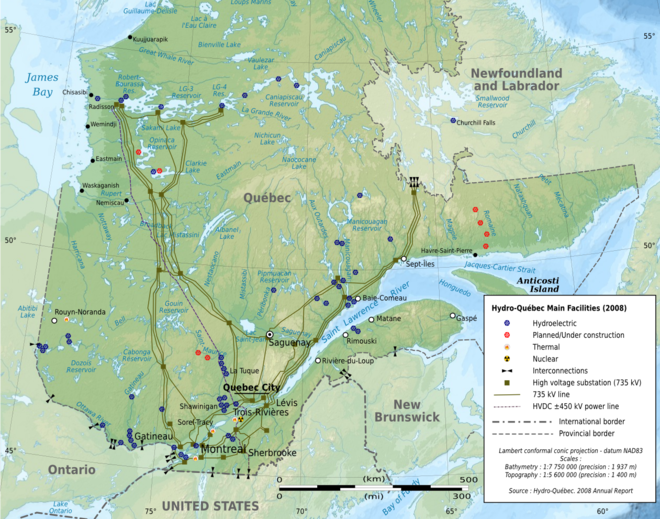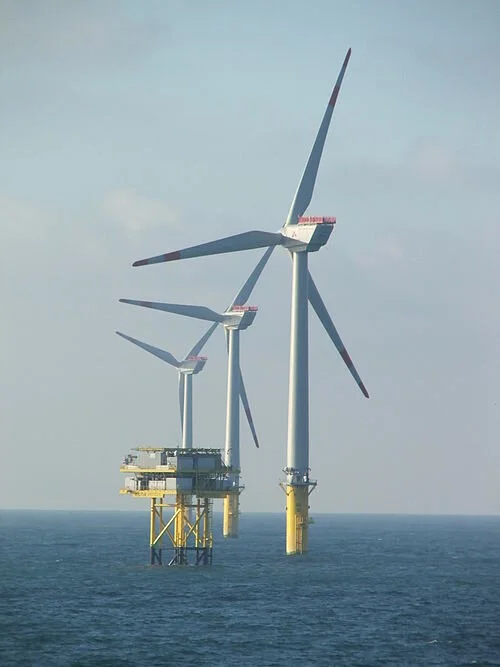
Tim Faulkner: Two-way electricity trading between N.Y., New England and Quebec
A 2008 map of Hydro Quebec facilities
From ecoRI News (ecori.org)
An MIT study claims that hydropower from Quebec can provide stored energy and solve the intermittency issues afflicting wind and solar power. Researchers at the MIT Center for Energy and Environmental Policy Research illustrate how “two-way” electricity trading between New England, New York and Quebec can reduce energy-system costs, decrease natural-gas use, and limit the need for emerging technologies such as carbon capture and sequestration.
To get there, 4 gigawatts of new transmission lines must built between New England and Quebec so that existing hydropower reservoirs can send power on demand.
Meanwhile, attorneys general from Rhode Island and Massachusetts signed on to a letter in support of a 2018 rule by the Federal Energy Regulatory Commission that requires utilities to include energy storage in wholesale electricity markets. The rule is being appealed by utilities through groups such as the American Public Power Association over anticipated cost increases. The states say the rule would create billions in economic and environmental benefits.
Mayflower Wind record price
The 804-megawatt Mayflower Wind project being developed by Royal Dutch Shell and EDP Renováveis in the wind-energy zone south of Martha’s Vineyard and Nantucket was recently awarded a power-purchase contract of 5.8 cents per kilowatt-hour from the Massachusetts utilities that will be buying the electricity. The price agreement offered by Eversource, National Grid, and Unitil needs to be approved by the Massachusetts Department of Pubic Utilities.
The record low price is less than the previous low of 6.5 cents for the 800-megawatt Vineyard Wind project.
More than $70 billion of potential investments in offshore wind facilities are proposed between North Carolina and Maine, but all await the outcome of an overdue federal environmental review on the Vineyard Wind project by the federal Bureau of Ocean Energy Management.
Public comment for offshore wind
The public has until March 16 to comment on a Coast Guard proposal for the layout and navigable shipping routes for the seven leased wind areas in federal waters. The Massachusetts and Rhode Island Port Access Route Study recommends spacing of 1 nautical mile between the turbines. Developers generally favor the layout, while the commercial fishing industry prefers 4-mile transit corridors and a design that limits radar interference.
Tim Faulkner is an ecoRI News journalist.
Tim Faulkner: Is fossil-fuel-loving Trump regime trying to sabotage offshore wind?
Vineyard Wind is coming to terms with the fact that its wind project is behind schedule, as accusations of political meddling escalate.
On Feb. 7, the federal Bureau of Ocean Energy Management (BOEM) released an updated permitting guideline that moved the facility’s likely completion date beyond Jan. 15, 2022 — the day the $2.8 billion project is under contract to begin delivering 400 megawatts of electricity capacity to Massachusetts.
Vineyard Wind is now renegotiating its power-purchase agreement with the three utilities that are buying the electricity. The company is also in discussions with the Treasury Department about preserving an expiring tax credit.
The delay is being caused by a holdup with BOEM’s environmental impact statement (EIS). A draft of the report was initially expected last year, but after the National Marine Fisheries Service and the National Oceanic and Atmospheric Administration declined to endorse the report, it was pushed off until late 2019 or early 2020. Back then several members of Congress from Massachusetts claimed the delay was politically motivated.
BOEM now is predicting that the draft EIS won’t be ready until June 12, with a final decision by Dec. 18. The setback is significant because the draft EIS is being counted on to shape the mapping of other offshore wind facilities slated for the seven federal wind-energy lease areas off the coasts of Rhode Island and Massachusetts.
The Coast Guard recently released its Massachusetts and Rhode Island Port Access Route Study (MARIPARS). The report favors the grid design proposed by wind developers and discounted concerns about radar interference.
This navigational safety report also recommends that if the turbine layout in the entire Massachusetts and Rhode Island wind area is developed using “a standard and uniform grid pattern” then special vessel routing lanes wouldn’t be required.
The Coast Guard’s findings improve the prospect for development of all seven wind-energy lease areas. But the MARIPARS report and the draft EIS both require public comment periods and hearings.
Lars Pedersen, CEO of Vineyard Wind, said of the setback, “We look forward to the clarity that will come with a final EIS so that Vineyard Wind can deliver this project to Massachusetts and kick off the new U.S. offshore energy industry.”
This latest delay has again been criticized by members of the Massachusetts congressional delegation as a ploy by President Trump to demonstrate his aversion to wind energy and his favoritism for fossil-fuel companies.
On Feb. 5, two days before BOEM released the new timeline, Massachusetts’ two U.S. senators and seven members of Congress sent a letter to the U.S. Government Accountability Office expressing their outrage over Trump’s hypocrisy.
“Despite seeking expedited environmental reviews for numerous fossil fuel infrastructure projects, Trump administration officials in the Department of the Interior have ordered a sweeping environmental review of the burgeoning offshore wind industry, a move that threatens to stall or even derail this growing industry, and raises a host of questions for future developments,” according to the letter.
In a recent interview with the Vineyard Gazette, Rep. Bill Keating, D-Mass., whose district includes Martha’s Vineyard, said he believes BOEM planned to release the draft EIS much sooner, but stalled the report after political pressure from superiors in the Department of Interior or the Trump administration until after the presidential election in November.
“It’s clear to me that these are political decisions and not guided by wanting to mitigate environmental impacts,” Keating said.
When asked about the political interference, BOEM replied that the delays are caused by public comments that call for a more thorough review of a large and disruptive change to nearshore waters. Those comments cited the upsurge in new wind projects, an increase in the size of wind turbines used by Vineyard Wind, and potential conflicts with commercial fishing and navigation.
Meanwhile, investments in wind project port facilities continue along southern New England. Gov. Gina Raimondo has earmarked $20 million in her proposed budget for improvements to the Port of Davisville at the Quonset Business Park in North Kingstown, R.I. The work includes dredging, repair of an existing pier, and construction of a new pier.
Mayflower Wind, the next project after Vineyard Wind to win an energy contract from Massachusetts, recently announced its intention to make the New Bedford Marine Terminal its primary construction hub for its 804-megawatt project.
Tim Faulkner is an ecoRI News journalist.
Wind-farm configurations
From Robert Whitcomb’s “Digital Diary,’’ in GoLocal24.com
Predictability and standardization are generally sought by businesses, large and small. Thus it should be good news that five companies seeking to set up offshore wind-turbine farms off southern New England have agreed to a common layout for their projects: a standard east-west orientation, with each turbine a nautical mile apart. That’s mostly to try to satisfy fishermen, some of whom express the (exaggerated) fear that the wind farms would reduce their ability to maneuver.
The five companies are Vineyard Wind, Eversource Energy, Mayflower Wind, Orsted North America and Equinor Wind.
The Trump administration, in thrall to the Red State-based fossil-fuel industry, seems to be using some fishermen’s complaints as cover in trying to stop some big renewable-industry projects, which the regime, as with “green energy’’ projects in general, associates with Democrats.
An irony in all this is that the supports for turbine towers act as reefs that attract fish.
The long debate about offshore wind farms continues as signs rapidly multiply that global warming caused by burning oil, gas and coal is accelerating, along with the damage it’s doing, although most people are not yet concerned enough about the crisis to push for serious political and policy action to reverse it. Some of those actions would indeed be quite inconvenient.



